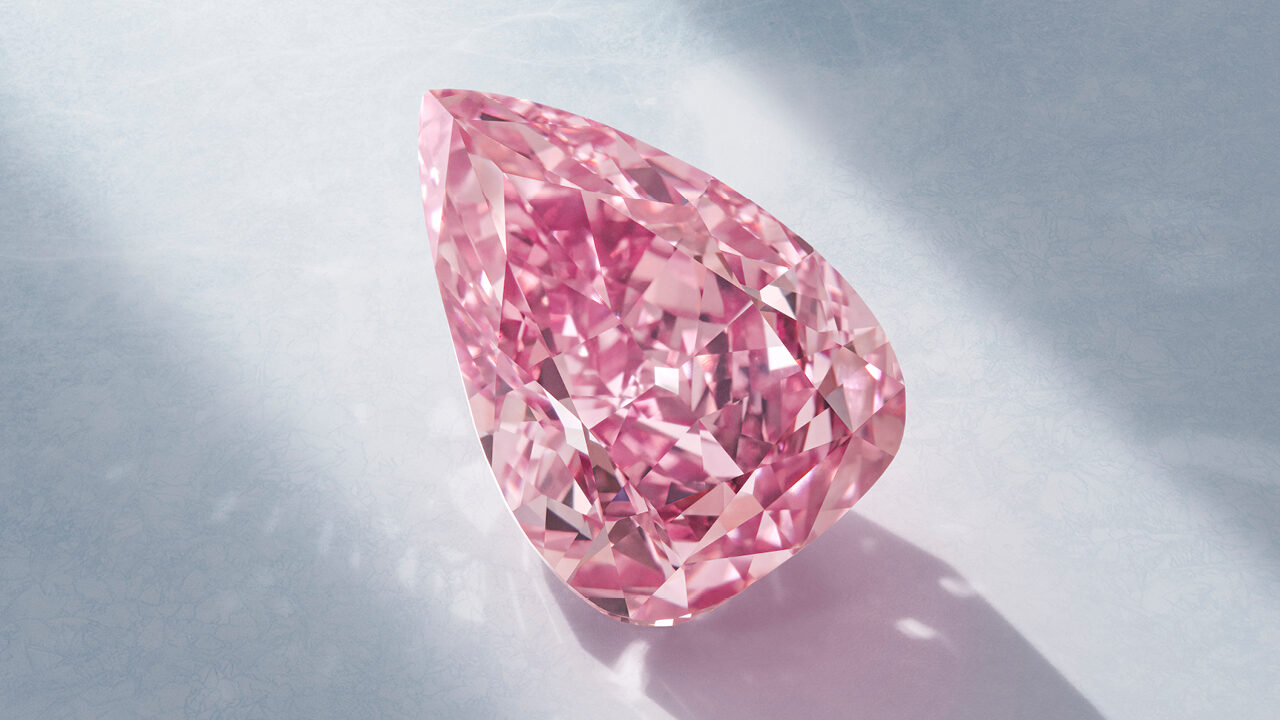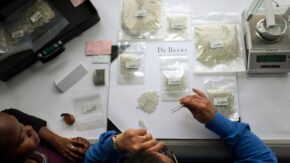After a slew of headline-grabbing prices, top colored diamonds have started tapering off. Experts say market fatigue may be denting the wow factor.
At the 2022 spring auctions, a number of showstopping colored diamonds grabbed the spotlight, selling for eye-watering amounts that only the top 1% to 2% of society could bear to part with.
At Sotheby’s Hong Kong in April, the De Beers Cullinan Blue — a 15.10-carat, fancy-vivid-blue diamond — fetched $57.5 million, well above its $48 million high estimate. In May, Christie’s Geneva sold the 205.07-carat, fancy-intense-yellow Red Cross diamond for $14.3 million against a presale price tag of $10.5 million. The Williamson Pink Star made headlines as late as October; Sotheby’s garnered a cool $57.7 million from the 11.15-carat, fancy-vivid-pink stone, nearly three times its $21 million high estimate. Even during the worst of Covid-19, sales of large colored diamonds seemed to flout the slowdown that other luxury items were witnessing.
But in the latter half of 2022, these phenomenally rare gems began to lose steam. Some were not selling at all, like the 5.53-carat blue from De Beers that Sotheby’s Geneva offered for $15 million in November. Two other blues from the same collection made their debut at the auction house’s December New York sale, but they, too, failed to find buyers. Others stones only just passed their low estimates, such as the 18.18-carat Fortune Pink, which sold at Christie’s Geneva in November for CHF 28.4 million ($28.9 million). And then there was the 13.15-carat, fancy-vivid-pink stone that was withdrawn before the December 6 auction at Christie’s New York, despite its having an upper estimate of $35 million (although this one allegedly turned out to be stolen goods).
Most recently, the 303.10-carat, fancy-deep-brownish-yellow Golden Canary diamond sold for $12.4 million at Sotheby’s New York. Prior to that auction, senior vice president and head of jewelry Quig Bruning had struck an optimistic note: “With this particular stone, the fact that it is being sold without [a reserve price] has brought many, many, many other people into the fray who may not have initially been desirous of buying an item like this. We’re putting this out there in an honest-to-goodness way where the market is going to drive the price for it. And…the more bidders you have on an individual item, the higher the price.”
While Sotheby’s was happy with the sum it ultimately fetched, the auction house had expected it to bring in more than $15 million.
These instances of diamonds underselling may not represent a permanent shift, but they do beg the question: What’s different now, and why are these once sought-after jewels floundering? There are a number of reasons, experts say, ranging from the economic downturn to a general sense of market fatigue.
Changing of the guard
In the past, Russian and Hong Kong billionaires were the primary buyers of large diamonds. However, the sanctions against Russia due to the Ukraine war have limited participation in auctions, as have the strict Covid-19 measures in China that curbed travel to Hong Kong toward the end of last year.
“Although Chinese buyers have agents, relatives and friends in Hong Kong to purchase for them, I think people are being extremely cautious…due to a fresh wave of the virus and its effect on the economy,” colored-diamond dealer Harsh Maheshwari told Rapaport in November. The executive director of Hong Kong-based Kunming Diamonds explained that “right now, [buyers would] rather sit tight and stay liquid, and probably spend on other things such as travel, Christmas, and potentially the Chinese New Year.”
Amid the disappearance of traditional buyers, the Middle East has emerged as a strong contender for large, high-quality colored diamonds, but the region has shown a strong preference for stones larger than those currently on offer, Bruning tells Rapaport Magazine. “I think what we are seeing is a bit more selectivity in terms of what people are really looking for,” he says. “People are just being a little pickier about these individual stones.”
In the shadow of recession
It’s debatable whether inflation and the prospect of economic recession are actually preventing people from spending large sums on big colored diamonds. Prices are rising, and money is tight for the general public, but those factors are unlikely to be deterring the crème de la crème of society.
“While the world economy is struggling in general right now, the 2% of the [population] that buys these stones is not struggling as much,” says Jonathan Abram, director of Hong Kong-based jeweler and dealer Ronald Abram.
But even if affluent buyers aren’t suffering financially, Bruning believes the current market may give them pause when it comes to high-value luxury items. “I think there is a little bit of hesitation for some people to pull the trigger on $10 million-plus purchases.”
It’s also possible that some of the jewels at the fall auctions were priced a bit high for the market, suggests Jill Burgum, executive director of fine jewelry for Heritage Auctions. “When you start working with gems in that echelon, pricing it correctly becomes very challenging.”
But beyond that, the auction houses may be trying too hard to play up the diamonds’ market value. “If an auction house tries to establish too strong of an estimate, or is trying to sort of drive a price, to set the market, that would be a bad approach to take,” she continues. “It’s better to go in softer, attract more people, and get a bidding frenzy going so people don’t drop out.”
On that point, Bruning admits that no matter how much experience one has in the field, there is no way to have absolute knowledge of how a piece will do or how much it will appeal to the buying public.
“One of the joys and ulcer-inducing moments of an auction is that when you put something up for [sale], well — I can sit here and, with a reasonable degree of certainty, go through the sale and say, ‘This is going to sell for X, this is going to sell for Y,’” he says. “But there are times when you just put your hands up and say, ‘I don’t know what the market is going to say about this stone on a given day. I don’t know where it’s going to end up.’”
Taking it to art
Part of high-end colored diamonds’ appeal is their long-term value, which is one reason they’ve always been a strong investment channel for wealthy Asian buyers. However, some believe that pendulum may be swinging toward other assets as the younger generation enters the market.
“In Asia, you have a lot of second or third generations of wealth that are less interested in diamonds and jewelry, because their parents made those acquisitions and they’re going to inherit those items,” explains Abram. “So they prefer to get into something their parents have not collected, such as art, which has more of a community and culture around it, and the galleries provide far more of a social aspect than jewelry.”
Maheshwari agrees, but maintains that what’s old will be new again soon enough. “The term we use is ‘little emperors,’ who want to start off within the luxury space by getting into buying wines, art and even watches. But I believe that the older they get, they also start understanding jewelry and colored diamonds, so it’s just a matter of time before they return.”
Creating a new legacy
Another possible reason for the decline in large diamonds’ auction prospects has to do with the desire for a legacy. Many bidders, especially in Asia, want to acquire something they can pass on to posterity — and for some, a resold item may not fit the bill.
“The Williamson Pink Star and the De Beers Cullinan Blue were both newly cut stones,” explains Abram. “Legacy is very important to buyers of that category, and by acquiring these stones, they are able to create their own legacy, not take part in a legacy that already exists.” The stones that underperformed at the fall auctions had all been up before and undergone recutting or repolishing, he adds.
Bruning, however, disagrees with the notion that a legacy item has to be new to appeal to Asian buyers. Some of the most valuable diamonds ever sold have had a second go-around or more on the auction block, he notes.
“If you look at some of the diamonds that historically have achieved massive prices, like the CTF Pink Star, the Zoe diamond, or the Graff Yellow, none of those were new, and many of those were bought by Asian collectors,” he elaborates. “So no, I don’t think that creating a new legacy is really a factor. That doesn’t hold water for me.”
Still, Burgum believes there is some truth to the theory. “The key phrase is ‘fresh to market,’ and yes, if it’s the first time an item is being offered at auction, there can be more buzz around it,” she says.
The hunt for exclusivity
Although all these factors likely contributed to the slowdown in the market, there are bigger issues to consider. What draws buyers to large colored diamonds at auction is the chance for an exclusive purchase, something no one else has. But lately, even the exclusivity of these stones is starting to look questionable.
“One factor is that people have been told these items are extremely rare, but now they’re seeing them quite often,” says Abram. “Also, the items are promoted very [heavily] on social media, so a lot of buyers are repeatedly seeing pictures of these very important stones.” And while they are rare, he explains, “seeing them too often may change that perception.”
Like many markets, the auction market is cyclical. Yellow diamonds, which have traditionally been a steady block offering, started tapering off about two years ago, independently of Covid-19, according to Bruning.
“Prices just dropped in a material way by about 20% to 25% across the board, and because they dropped, it led to a reconsideration [on a macro level] of how many yellow diamonds we should put on the market,” he says. “And I think, if you were to look at auctions from 2020 until the end of [2021], first half of [2022], you would see fewer yellow diamonds than in previous time periods. And the benefit of that is, we are now seeing a significant increase in demand and prices for yellow diamonds.”
That’s where rarity comes in. “While I think there are still blues and pinks moving at high prices,” he continues, “they really need to have the rarity factor [as] a major part of how they achieve those prices.”
Too much of a good thing
In that vein, one of the biggest issues plaguing the auction industry may be market fatigue. The big colored diamonds that come to auction are all about the wow factor, but that starts to fade when every auction touts the most spectacular 10-carat-plus pink or blue diamond ever. One may be the biggest oval-shaped pink, another the biggest fancy-vivid-blue diamond, but in reality, these modifiers are of minuscule importance. Buyers see similar colored diamonds debuting again and again. It may well have been the Fortune Pink’s arrival on the scene so soon after the Williamson Pink Star’s explosive success that kept the former from achieving a higher price.
“There have been a lot of these stones coming on the market, and at some point, it becomes a little bit difficult to continue to maintain this idea of extraordinary rarity when you have one after the next,” says a source close to the auction houses. “That’s a challenge, and…there is probably some market fatigue, particularly [for vivid stones] of a certain size.”
Maheshwari worries about the effect this influx of “special” diamonds will have on the colored-stone market as a whole. “I definitely feel that people are overfeeding the auctions with too many colored diamonds,” he says. He believes there may be better opportunities outside the auction circuit, where there is more anonymity and less similarity of merchandise.
“I think larger stones are selling better away from the auction houses, because there are a lot of buyers who don’t want their diamonds publicized,” he explains. “I just had a call for a large 10-plus-carat blue diamond, and the VIP client didn’t want to buy at auction. They want a stone nobody has seen. It’s just the exclusivity of it.”
While Heritage Auctions doesn’t generally deal in such large colored diamonds, Burgum knows the market well. She agrees that it can be hard to maintain momentum for a product that seems to be in such strong supply, and she sees this as perhaps the biggest problem.
“I’d like to think that the top 1% isn’t as affected by the dip in the stock market or the war with Ukraine,” she says. “I think the money is still out there. My question would be…are there too many of these big, rare treasures coming on the market too close together? Because then they can lose a little bit of their luster. [That] is probably not advantageous to the market.”
Image: The 18.18-carat Fortune Pink diamond, which sold at Christie’s in November for $28.9 million. (Christie’s)



